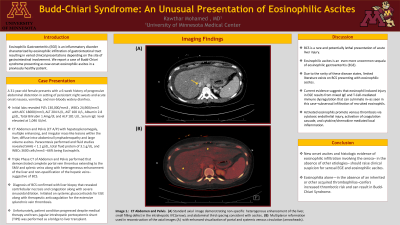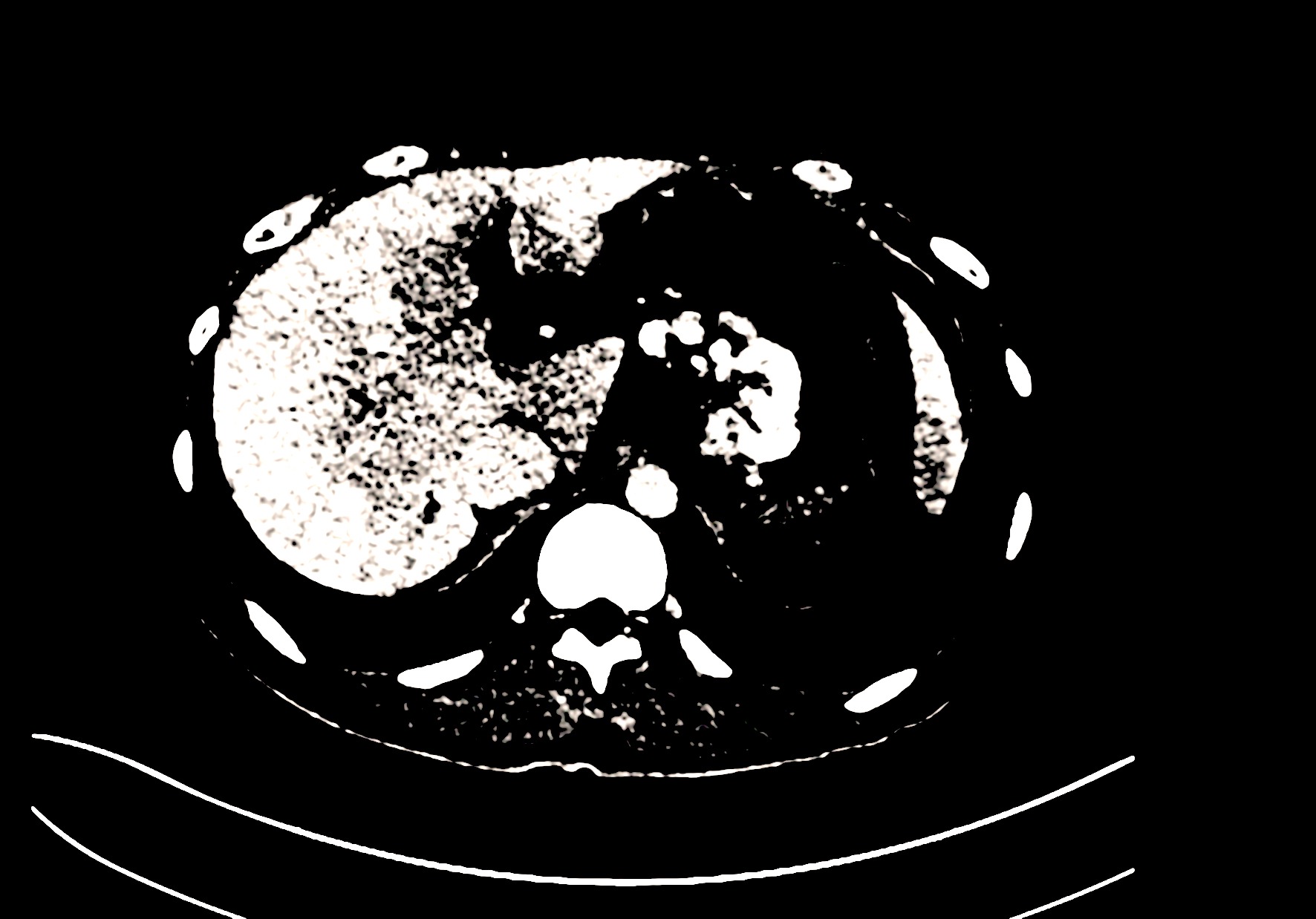Sunday Poster Session
Category: Liver
P1086 - Budd-Chiari Syndrome: An Unusual Presentation of Eosinophilic Ascites
Sunday, October 22, 2023
3:30 PM - 7:00 PM PT
Location: Exhibit Hall

Has Audio
- KM
Kawthar Mohamed, MD
University of Minnesota
Minneapolis, MN
Presenting Author(s)
Kawthar Mohamed, MD
University of Minnesota, Minneapolis, MN
Introduction: Eosinophilic Gastroenteritis (EGE) is an inflammatory disorder characterized by eosinophilic infiltration of gastrointestinal tract resulting in varied clinical presentations depending on the site of gastrointestinal involvement. We report a case of Budd-Chiari syndrome presenting as new-onset eosinophilic ascites in a previously healthy patient.
Case Description/Methods: A 31-year-old female presents with a 6-week history of progressive abdominal distention in setting of persistent night sweats and acute onset nausea, vomiting, and non-bloody watery diarrhea. Initial labs revealed PLTs 130,000/mm3 , WBCs 24,900/mm3 with AEC 18000/mm3, ALT 204 IU/L, AST 100 U/L, Albumin 2.8 g/dL, Total Bilirubin 1.4mg/dL and ALP 181 U/L.Serum IgE level elevated at 1,046 IU/ml. CT Abdomen and Pelvis (CT A/P) with hepatosplenomegaly, multiple enhancing, and irregular mass-like lesions within the liver, diffuse intra-abdominal lymphadenopathy and large volume ascites. Paracentesis performed and fluid studies revealed SAAG < 1.1 g/dL, total fluid protein of 3.1 g/dL, and WBCs 3600 cells/mm3 –66% being Eosinophils. To better characterize mass-like lesions, Triple-phase CT A/P done which revealed complete portal vein thrombus extending to the SMV and splenic veins along with heterogeneous enhancement of the liver and non-opacification of the hepatic veins–suggestive of BCS. Diagnosis of BCS confirmed with liver biopsy that revealed centrilobular necrosis and congestion along with severe sinusoidal dilation. Initiated on systemic glucocorticoids for EGE along with therapeutic anticoagulation for the extensive splanchnic vein thrombosis. Unfortunately, patient condition progressed despite medical therapy and trans-jugular intrahepatic portosystemic shunt (TIPS) was performed as a bridge to liver transplant.
Discussion: BCS is a rare and potentially lethal presentation of acute liver injury. Even more uncommon is eosinophilic ascites as a sequala of eosinophilic gastroenteritis (EGE). Due to the rarity of these disease states, limited literature exists on BCS presenting with eosinophilic ascites. Current evidence suggests that eosinophil induced injury in EGE results from mixed IgE and Tcell-mediated immune dysregulation that can culminate in–as seen in this case–subserosal infiltration of recruited eosinophils. Activated eosinophils promote venous thrombosis via cytotoxic endothelial injury, activation of coagulation cascade, and cytokine/chemokine mediated local inflammation.

Disclosures:
Kawthar Mohamed, MD. P1086 - Budd-Chiari Syndrome: An Unusual Presentation of Eosinophilic Ascites, ACG 2023 Annual Scientific Meeting Abstracts. Vancouver, BC, Canada: American College of Gastroenterology.
University of Minnesota, Minneapolis, MN
Introduction: Eosinophilic Gastroenteritis (EGE) is an inflammatory disorder characterized by eosinophilic infiltration of gastrointestinal tract resulting in varied clinical presentations depending on the site of gastrointestinal involvement. We report a case of Budd-Chiari syndrome presenting as new-onset eosinophilic ascites in a previously healthy patient.
Case Description/Methods: A 31-year-old female presents with a 6-week history of progressive abdominal distention in setting of persistent night sweats and acute onset nausea, vomiting, and non-bloody watery diarrhea. Initial labs revealed PLTs 130,000/mm3 , WBCs 24,900/mm3 with AEC 18000/mm3, ALT 204 IU/L, AST 100 U/L, Albumin 2.8 g/dL, Total Bilirubin 1.4mg/dL and ALP 181 U/L.Serum IgE level elevated at 1,046 IU/ml. CT Abdomen and Pelvis (CT A/P) with hepatosplenomegaly, multiple enhancing, and irregular mass-like lesions within the liver, diffuse intra-abdominal lymphadenopathy and large volume ascites. Paracentesis performed and fluid studies revealed SAAG < 1.1 g/dL, total fluid protein of 3.1 g/dL, and WBCs 3600 cells/mm3 –66% being Eosinophils. To better characterize mass-like lesions, Triple-phase CT A/P done which revealed complete portal vein thrombus extending to the SMV and splenic veins along with heterogeneous enhancement of the liver and non-opacification of the hepatic veins–suggestive of BCS. Diagnosis of BCS confirmed with liver biopsy that revealed centrilobular necrosis and congestion along with severe sinusoidal dilation. Initiated on systemic glucocorticoids for EGE along with therapeutic anticoagulation for the extensive splanchnic vein thrombosis. Unfortunately, patient condition progressed despite medical therapy and trans-jugular intrahepatic portosystemic shunt (TIPS) was performed as a bridge to liver transplant.
Discussion: BCS is a rare and potentially lethal presentation of acute liver injury. Even more uncommon is eosinophilic ascites as a sequala of eosinophilic gastroenteritis (EGE). Due to the rarity of these disease states, limited literature exists on BCS presenting with eosinophilic ascites. Current evidence suggests that eosinophil induced injury in EGE results from mixed IgE and Tcell-mediated immune dysregulation that can culminate in–as seen in this case–subserosal infiltration of recruited eosinophils. Activated eosinophils promote venous thrombosis via cytotoxic endothelial injury, activation of coagulation cascade, and cytokine/chemokine mediated local inflammation.

Figure: CT TRIPLE PHASE
Disclosures:
Kawthar Mohamed indicated no relevant financial relationships.
Kawthar Mohamed, MD. P1086 - Budd-Chiari Syndrome: An Unusual Presentation of Eosinophilic Ascites, ACG 2023 Annual Scientific Meeting Abstracts. Vancouver, BC, Canada: American College of Gastroenterology.
